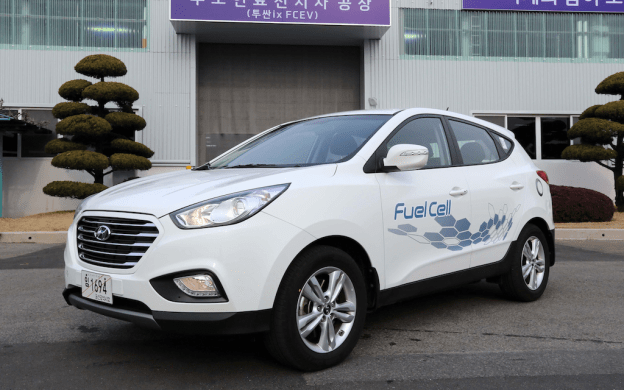
Hyundai announced that it has successfully built the world’s first assembly line production hydrogen fuel-cell vehicle. Hyundai says it will build 1000 units of its ix35 (or Tucson as we know it here in the States) hydrogen-powered crossover, the first of which will make their way to Europe as fleet vehicles for dozens of municipalities.
While other automakers have had hydrogen fuel-cell cars for years – Mercedes-Benz’s F-Cell and Honda’s FCX Clarity spring to mind – none have made the jump to full blown production vehicle. Marking Hyundai as an industry leader, and earning an unofficial gold star (or is that green star?) in the process.
The fuel-cell-powered ix35 has been given a distinctive grille, front bumper, fog lamps, instrument cluster, and a seven-inch satellite navigation screen to apparently enhance its marketability.
The ix35 hydrogen drive system works by taking onboard hydrogen and converting it into electricity with what is called a “fuel stack.” That generated electricity then powers the ix35’s electric motor, thereby driving the wheels. Additional power is stored in a lithium-ion battery pack. Unlike traditional gasoline or diesel hybrids, the fuel-cell car produces only water vapor emissions.
While the powertrain is a bit unconventional, the performance is similar to that of a standard gasoline-powered Hyundai Tucson. The fuel-cell power output is rated at 134 horsepower. The ix35 will go 0-62 MPH in 12.5 seconds and hit a top speed of 100 MPH. The full range has been estimated at 370 miles per “tank” of hydrogen.
Why does Europe get most of the first 1000 ix35s? The European Union has paved a roadmap toward hydrogen-powered cars and invested in the initialization of hydrogen fueling stations across the continent. According to Hyundai, the ix35 aligns with the 2009 agreement by the European Union’s G8 countries to reduce carbon emissions by 80 percent by 2050 and California’s Zero Emission Vehicle regulations.
Hyundai’s press release didn’t indicate how many of the ix35s would be headed to the U.S. market, how much they would sticker for, and when we could expect them to roll out.
We reached out to a Hyundai representative for an answer but have yet to receive any further details.


